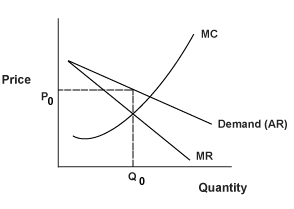A firm engaged in monopolistic competition which is considering reducing prices in order to increase total revenue has two conflicting factors to consider. Reducing prices will increase the quantity of a good sold, but the reduction in price will also apply to quantities of the good that would have been sold at a higher price.
The price searcher can maximize profit by adjusting output and the price until marginal revenue is equal to marginal cost. Notice that the marginal revenue curve lies below the firm's demand curve.
Figure 3.15: Marginal Revenue Curve In Monopolistic Competition

The phrase "contestable markets" describes markets where there are few sellers, but they behave in a competitive manner because of the threat of new entrants. For instance, an airline may serve a particular route exclusively, but does not charge excessive prices because those prices would entice additional airlines to offer that route.
Government regulation is often used to keep new firms out of markets. Economists generally favor deregulation as this helps to keep prices low.
Prices over the long run in a competitive market will move to the lowest point of the firm's average total cost curve. We then have allocative efficiency because desired goods are produced at the lowest possible cost.
Because price searchers face downward-sloping demand curves, the price they charge will exceed the firm's marginal cost. The price charged and the quantity produced will not be where the firm minimizes average total costs. Figure 3.16 illustrates these points.
Figure 3.16: Monopolistic Competition: Low Barriers to Entry

The monopolistic competition market, in comparison to a purely competitive market, will have a higher price and lower output. Some argue that this is a good trade-off, as consumers benefit from having a variety of goods. Advertising would be not be used by price-takers, but is used by price-searchers; as the cost of advertising is ultimately borne by consumers, it is an argument against the price-searcher market.
If barriers to entry are low, firms still have an incentive to produce efficiently, use resources only if they add value and innovate by altering their products or offering new products. Entrepreneurs may have more incentives with price searcher markets, while if markets are contestable, prices will not be excessively higher than those in competitive markets.
Product Development and Marketing in Monopolistic Competition
Firms engaged in monopolistic competition invest in product development and marketing so as to differentiate themselves from other firms in the industry. By doing so, they hope to gain more monopolistic pricing power. Since advertising increases costs, it will shift supply curves up and to the right.
Ultimately, over the long run, consumers pay for the advertising in the form of higher prices.
In comparison to the pure competitive market, prices will be higher and quantities produced will be lower when there is monopolistic competition. However, there will be a greater variety of goods. This may be a worthwhile tradeoff.






0 comments:
Post a Comment